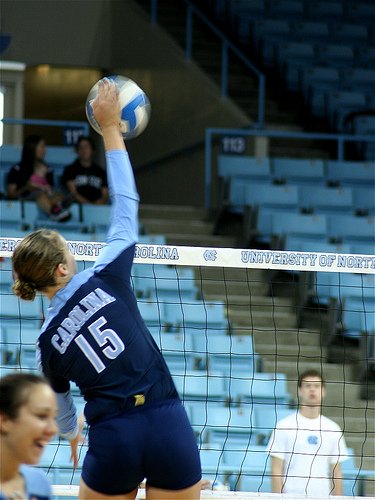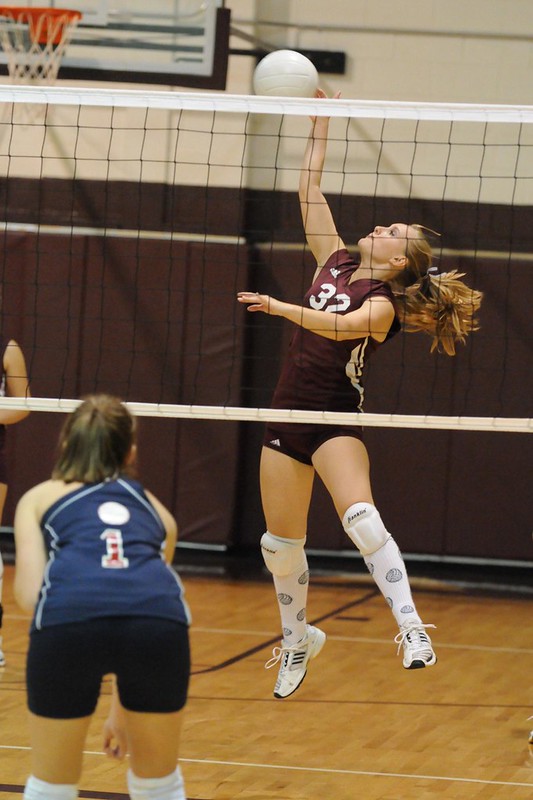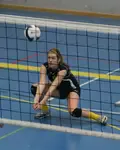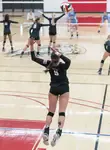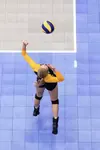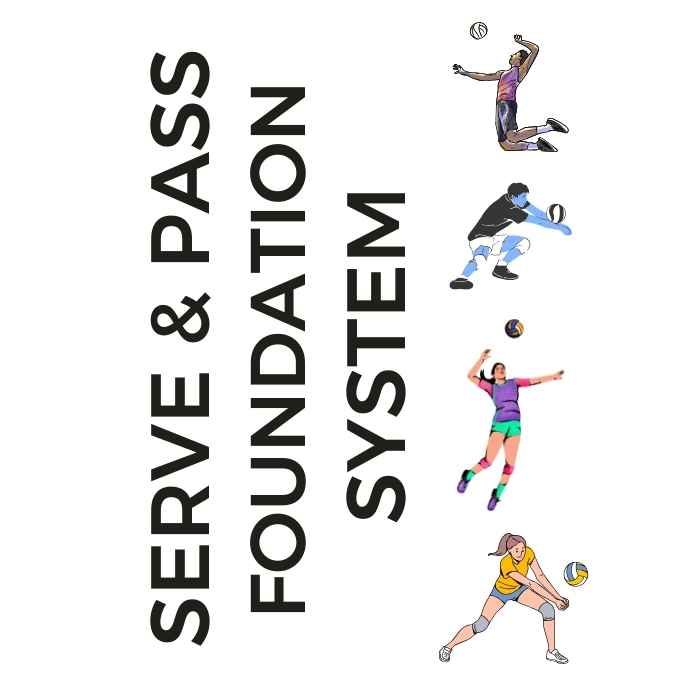
Serve + Pass Foundation System: The Complete Skills Arsenal The two-skill mastery system that transforms inconsistent players into the athletes coaches build their lineups around. Stop Struggling With The Two Most Important Skills In Volleyball!
- Improve Your Volleyball with Coach April
- Questions For Volleyball Players
- Hard Driven Spike in Volleyball
A Hard Driven Spike in Volleyball And Court Zones You Should Aim For
These volleyball terms describe the court zones where outside hitters are taught to aim their hard driven spike in volleyball to score points in a rally.
 NOVEMBER Group Volleyball Training with Coach April Registration is NOW open for Group Volleyball Training Sessions with me Coach April For BOYS on SATURDAYS 11/8, 11/22, 11/29 For GIRLS on SUNDAYS 11/9, 11/23, 11/30 From 10-11am at the Its All Volleyball gym. Email: info@improveyourvolley.com to register or for more information
NOVEMBER Group Volleyball Training with Coach April Registration is NOW open for Group Volleyball Training Sessions with me Coach April For BOYS on SATURDAYS 11/8, 11/22, 11/29 For GIRLS on SUNDAYS 11/9, 11/23, 11/30 From 10-11am at the Its All Volleyball gym. Email: info@improveyourvolley.com to register or for more informationThis list of volleyball words describe the zones on the court that varsity outside hitters are taught to aim their spike in volleyball for in order to score points in a rally.
Watch Adlai and Christian work on their hard driven spike in volleyball frpm Zone 4 to the opposing team's cross court.
The Hard Driven Spike in Volleyball
The Line Shot: Hitting Down The Line
The Line Shot: Hitting Down The Line
Right side hitters spiking from RF, right front or zone 2, would hit a line shot if they spike a ball or send an offspeed shot in or near zone 4 or zone 5 of the opposing team's court.
The Hard Driven Spike in Volleyball
The Cross Court Shot: Hitting Cross Court
Reserve your private one-on-one volleyball lessons or small group training at https://www.improveyourvolley.com/volleyball-classes.html. Contact info@improveyourvolley.com
The Cross Court Shot: Hitting Cross Court
A cross court hit occurs when a hitter contacts the top third of the ball with their thumb turned down which directs a hard driven spike in volleyball to a court zone located within the opposite sideline from where they are attacking from.
If you're a left side hitter attacking a ball from Zone 4 on your side of the net and your hard driven spike in volleyball lands anywhere inside Zone 4 or Zone 5 on the opposing team's side, then that's a cross court hit.
How do opposite hitters attack cross court?
If you're an opposite hitter attacking the ball from Zone 2, RF on your side and the ball lands inside zone 2 or zone 1 on the opposing team's side, then you've just made a cross court hit.
Working on hitting a hard driven spike in volleyball from the right side off my toss during my Breakfast Club class for players prepping for college.
The Hard Driven Spike in Volleyball
Hitting The Seam
Seam
The seam is another name for the hole in the block created when blockers hands don't close the space between them.
The hitter exploits the seam in the block by aiming their hard driven spike in volleyball right for that hole which is difficult for the back row defense to pick up and play if they don't have a libero or defensive player in place to specifically dig balls that have been hit through the seam.
The Hard Driven Spike in Volleyball
The Cut Shot
Cut Shot
The cut shot or the "cutty" is used by a player who is in zone 2 on their court and attacks the ball with an off-speed shot to zone 2 of the opposing team's court.
This shot is primarily used in beach volleyball and is very effective as a hitting option for players.
The Hard Driven Spike in Volleyball
The Backrow Attack
Backrow Attack
The setter can set the strong hitter that has rotated to the back court.
If the hitter starts their spike approach steps from behind the ten foot line, then hits the ball while they are in the air above the ten foot line and lands in front of it, that is still a legal hit.
Frequently Asked Questions about the Hard Driven Spike in Volleyball
Q: What is a hard driven spike in volleyball?
The player jumps into the air and strikes the ball forcefully downward towards the opponent's court with the intention of making it difficult for the opposing team to defend or return the ball.
 A hard driven spike in volleyball refers to a powerful and aggressive offensive attack shot made by a player to score a point. (photo Dan Morgan)
A hard driven spike in volleyball refers to a powerful and aggressive offensive attack shot made by a player to score a point. (photo Dan Morgan)Q: What are the key elements of a successful hard driven spike?
A: Successful hard driven spikes require a combination of good timing, technique, and power. The player must approach the ball with a strong spike approach, jump explosively, make clean contact with the ball using a solid arm swing, and aim for specific court zones to maximize their chances of scoring a point.
Adlai sets All West Coast Conference opposite hitter for BYU and Boulder City High school 2x -3A state champion Kate Prior during private volleyball coaching sessions.
Kate Prior is a 3 year private client of mine for the last few years of her high school volleyball career.
Q: What court zones do hitters aim for when executing a hard driven spike?
A: Hitters aim for different court zones based on their position and the type of shot they intend to make.
Generally, outside hitters aim for zones 4 and 5 on the opposing team's court, targeting the areas near the sideline and backline. Right side hitters usually aim for zones 2 and 4, while middle hitters aim for zones 2 and 3.
Q: How can I improve my ability to execute a hard driven spike?
A: To improve your hard driven spike, focus on developing your overall strength, vertical jump, and arm swing technique. Regularly practice your spike approach, timing, and footwork. Work on strengthening your core, legs, and shoulder muscles through specific exercises. Seek feedback from coaches or trainers and practice with a supportive team environment.
Q: Is the hard driven spike only for front row players?
A: No, the hard driven spike is primarily associated with front row players who are typically the primary attackers. However, backrow players can also execute a hard driven spike from behind the ten-foot line as long as they stay within the legal boundaries. This is commonly known as a backrow attack.
Q: What are some strategies for defending against a hard driven spike?
A: Defending against a hard driven spike requires good positioning, anticipation, and quick reactions.
The defending team should form a solid block at the net to obstruct the hitter's attacking angles. Backrow defenders should be prepared to dig the ball, using proper footwork and body positioning to receive the hit with control. Communication and teamwork are also essential in coordinating defensive movements.
Q: Can a hard driven spike land out of bounds and still count as a point?
A: No, if a hard driven spike lands outside the boundaries of the opponent's court, it is considered out-of-bounds. As a result, the opponent will be awarded a point and the serving team will lose their serve. Hitters need to aim for the appropriate court zones to ensure the ball lands in play and has a chance to score a point.
Q: What are the common mistakes players make when attempting a hard driven spike?
A: Some common mistakes include improper footwork and approach, mistiming the jump, poor arm swing technique, and hitting the ball too high or too low. It's important to practice and refine these elements to maximize the effectiveness of your spike.
Q: Can players perform a hard driven spike with both hands?
A: No, a hard driven spike is typically executed with one hand. The other hand is used as a guide or balance during the approach and jump. Using both hands to strike the ball simultaneously is considered illegal in volleyball.
Q: Are there any specific drills that can help improve my hard driven spike?
A: Yes, there are several drills that can enhance your hard driven spike.
Some examples include practicing spike approaches and footwork, hitting against a block, working on different types of hits like line shots and cross-court shots, and incorporating game-like situations in your drills to simulate real match scenarios.
Q: Can height or vertical jump limit someone's ability to perform a hard driven spike?
A: While height and vertical jump can have an impact, they are not the only determining factors.
Proper technique, timing, and power are also crucial. Players of all heights can excel at executing hard driven spikes by focusing on their strengths and working on aspects like arm swing speed and accuracy. Additionally, improving overall fitness and strength can contribute to an increase in vertical jump height.
The Hard Driven Spike in Volleyball:
Where do you need to go now?
Here are three options:
- Learn more about the volleyball words, terms and terminology in the Related Links below.
- Follow the suggested reading on our Sitemap page Learning How To Play (Sitemap)
- Or visit the pages in the Information section in the drop down menu at the top of the page.
If your athlete struggles with consistent serve receive, gets subbed out, or is overlooked for playing time—this is the fix you’ve been looking for.

Struggling with passing consistency?
I help talented passers tired of getting pulled from games because of inconsistent serve receive skills BUILD passing confidence without expensive private lessons using the same 3-step system that's helped dozens of my athletes get recruited.
Download my eBook for $17.99 and start building the passing confidence that keeps you on the court—and gets you seen by college coaches.
From Lady Vol to Legend: Coach April Produces Powerful Passionate Players...is that you?
What Are You Looking For?
Click to Download Your Pre Serving Ritual Mastery Checklist pdf:
🎯Volleyball Pre Serving Ritual Guide -
Players! Learn How To Transform Your Serve from Weak to Weapon
Click to Download Your Parent's Volleyball Serving Checklist pdf
🎯Parent's Volleyball Serving Checklist Guide
Parents! Help Your Player Develop Championship Serves (Even If You've Never Played)

Hi there!
Thanks for stopping by. Hope you learned something today that will help you reach your volleyball goals.
Be sure to subscribe to my email newsletter so you can learn more each week!
Stay strong! Stay motivated!
-Coach April

SUSCRIBE to my email newsletter below!
 Click to learn more about the weekly volleyball classes and clinics or email info@imrpoveyourvolley.com for information
Click to learn more about the weekly volleyball classes and clinics or email info@imrpoveyourvolley.com for informationCongratulations to my seven Boys-18s Vegas Volley club players who played in two state championship finals yesterday, the 3A and 5A State champinship finals at Sunrise Mountain High School.
TOURNAMENT CHAMPIONS!
A-1 Vegas Volley VBC
In It To Win It Tournament
May 2 - 4, 2025 Tournament
Gold Medalists
18s Premier Division
Vegas Volleyball's Unsung Heroes: Celebrating Moms with Peace Love Volleyball Shirts
Ready to energize your volleyball mom journey?
Subscribe to my 'Producing Powerful Passionate Peaceful Players' email list above on ImproveYourVolley.com.
You'll receive energy-boosting tips, exclusive insights from me, Coach April Chapple on maintaining momentum in volleyball.
Let's power up the Vegas volleyball scene together!
Recent Articles
-
3 Beach Volleyball Hand Grips How Do You Hold Your Hands When Passing?
Dec 20, 25 05:32 PM
The purpose of the volleyball hand grip you use to pass a ball is to help keep your elbows straight and to insure you have a very flat and wide a platform. -
5 Essential Serving Tips from Tennessee's #2 Career Aces Record Holder
Dec 09, 25 11:39 PM
I've identified the 5 essential serving tips that separate confident servers from struggling ones and you'll serve with the confidence that creates aces -
The Volleyball Toss How Consistent Is Your Ball Toss Before You Serve?
Dec 07, 25 12:29 AM
The volleyball toss for the overhand serve needs to consistently be two feet up in the air and one foot in front of front foot which puts the ball in front of your serving arm.
